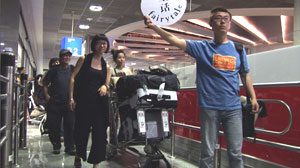The project began with an open invitation posted on Ai Weiwei’s personal blog to people from all over China to travel to Kassel. The 1001 “tourists,” as he calls them, were randomly selected from the thousands of applicants, among them working men, farmers, students, writers, artists, and peddlers from different parts of China-from Beijing to out-lying provinces. While there were no specific criteria for the selection, preference was nevertheless given to people for whom travel abroad would be of special significance and would have been impossible otherwise. Each applicant was asked to fill out a form composed by the artist, containing 99 questions such as: “Have you ever been to Germany?” “What is a fairytale?” “Can art change the world?” The forms, which were not used for screening purposes, express some of the project’s areas of interest, and the answers provide divergent, personal versions of thousands of individuals for questions pertaining to national identity and culture.
The selection phase was followed by a complex bureaucratic process of travel arrangements, for which the artist set up a temporary travel agency called Fake. With a team of 30 workers, it was responsible not only for the financial aspects, but also handled all the complex details involved in the travel and stay in Kassel of such a large group of people-from issuing passports and visas to accommodations, food, and even haircut arrangements. At this stage the passengers were confronted with more formal questionnaires required in order to secure the visa, passport, and even ID card in some cases. As opposed to Ai Weiwei’s philosophical, ethical, cultural, and personal questions, these questionnaires were aimed at defining identity in a formal, fixed manner by institutional bodies such as the governments of China and Germany. This juxtaposition of the personal and the public, the exploration of identity as comprised of private and personal as well as national and formal elements, are major themes addressed by the project, which form the core issues the film delve into.
The project consisted of two additional parts which were realized in Kassel: one included 1001 Chinese Ming and Qing dynasty wooden chairs shipped especially from China and scattered in various Documenta exhibition venues. The second project, Template, was a structure made of Ming and Qing dynasty door and window frames which the artist collected from demolished houses in old villages and towns. The resulting structure, reminiscent of a traditional Chinese temple, collapsed after only one day in the European rain.
The film was made as the concluding part of the project, encapsulating thousands of shooting hours which documented the process experienced by each passenger (Ai Weiwei himself described the project as 1001 discrete works). One is exposed to the reasons which led each of the participants to embark on the journey: the hopes, fears, and worries elicited in view of the procedures and the confrontation of issues they never had to consider previously, the team’s complex preparations for the project, the responses of Documenta visitors upon encountering the Chinese tourists, and the process undergone by the artist himself.
In addition to the perusal of Chinese identity in particular, and human identity in general, and the tension between the individual and his national-collective affiliation, the work focuses on the encounter between East and West. China’s contact with the West has now entered a new phase, where it functions as an influential force in the global economy. As such, China is considered more open to the West than it was in the past, yet it is still regarded as distinct from the West, enigmatic and different. In the past, the links between Europe and China were fragmented, characterized by long periods of dissociation, and centered mainly on export of goods, such as tea, porcelain, and silk. The exotic goods, alongside the partial information which infiltrated Europe over the years and the writings of Confucius and Lao-Tse, sparked the imagination and curiosity of the Europeans as to this fantastical, ancient land, a curiosity which found its way into the writings of European, mainly German, thinkers, from Leibnitz to Goethe and Hegel. These days, at the end of the Communist era, the Western encounter with Chinese groups is often linked with migrant workers, and China is perceived by the West as a source of cheep labor. In Fairytale, Ai Weiwei refers to this intricacy involving preconceptions and abstract ideas about China held by the West, and of course-ideas about Europe held by China, when he allows for an encounter between West and East on both the interpersonal and the conceptual levels.
Due to the length of the film it will be screened once a day.
Mon., Wed., Fri., Sat., 10:00 a.m.; Tues., Thurs., 4:00 p.m.
Herzliya Museum of Contemporary Art acknowledges Sherman Contemporary Art Foundation, through whose initiative the film ‘Fairytale’ was first exhibited.
Less Reading...
